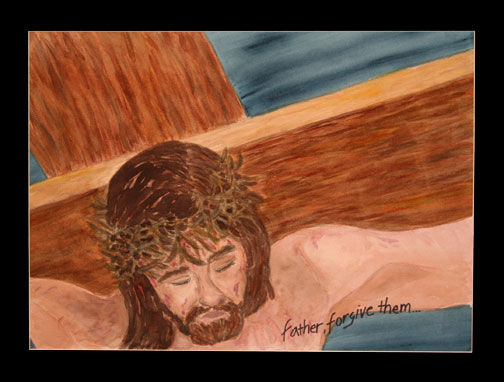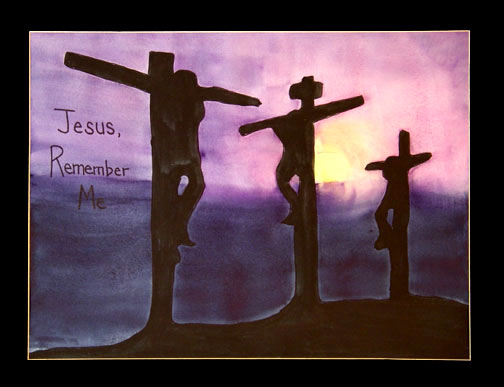Part 10 of series: The Stations of the Cross for Lent and Holy Week
Permalink for this post / Permalink for this series
Luke 23:33-4, 47
23:33 When they came to the place that is called The Skull, they crucified Jesus there with the criminals, one on his right and one on his left. Then Jesus said, “Father, forgive them; for they do not know what they are doing.” And they cast lots to divide his clothing.
23:47 When the centurion saw what had taken place, he praised God and said, “Certainly this man was innocent.”

Reflection
 |
|
| Above: The Church of the Resurrection in Jerusalem. Golgotha is believed to be under the large dome. Below: Inside the Church of the Resurrection. The actual place of Jesus’s crucifixion is on the left side of the photo.Bottom: Gordon’s Calvary does look a bit like a skull, but Golgotha probably got its name, not from this rock formation, but from the fact that so many people were crucified there.These photos are all from Holy Land Photos, a fantastic source of pictures. Used by permission. | |
 |
|
 |
According to Luke, Jesus was crucified at “the place that is called The Skull” (23:33). The other Gospels mention that it was called Golgotha, the Greek transliteration of the Aramaic word Gûlgaltâ that means “skull.” We get the English word “Calvary” by way of the Latin calvariae locum, which means, “place of the skull.”The precise location of Golgotha is not clear from Scripture. It was near Jerusalem according to John 19:20, and therefore, by implication, not in the ancient city proper. Hebrews 13:12 mentions that Jesus “suffered outside the city gate.” John 19:41 adds that there was a garden in the place where Jesus was crucified.
From the earliest days Christian tradition has identified the location of Golgotha in a place that is now within an ancient church in Jerusalem (the Anastasis Chuch, or Church of the Resurrection, also called the Basilica of the Holy Sepulchre). This church is now located near the center of Jerusalem. But in the first century this location was actually outside of the walls of the city.
Modern archeology has substantially confirmed the accuracy of traditional Christian belief about the location of Golgotha (Note 1). Since the nineteenth century, an alternative location for Jesus’s crucifixion has been popular. The so-called Gordon’s Calvary (near the Garden Tomb) does look somewhat like a skull, but most scholars don’t believe it was the location of Jesus’s death for a variety of sensible reasons.
Christians throughout the ages have made pilgrimages to Golgotha, walking along the Via Dolorosa, and pausing to remember the Stations of the Cross along the way. Since I’ve never been to Jerusalem, I’ve not yet had the chance to visit the place where Jesus died. I hope to do so at some point in my life.
Why? Why would I join the millions of Christians who have made a pilgrimage to Golgotha?
There’s something about being in the actual place where something momentous happened that makes the event more real. When I was in college, I used to ride my bike to Concord, Massachusetts, to the North Bridge, the place where “the shot heard round the world” began the War for Independence in 1775. As I leaned on that bridge and looked upon the peaceful countryside, I’d think about the men who died that day, and about the freedom I enjoy because of their sacrifice. I’d leave Concord with deeper gratitude for blessings I usually take for granted.
Sadly, I also can take the freedom I have in Christ for granted. For over four decades I’ve known that Jesus died for my sins. And, even though I’ve staked my life upon this good news, there are times when it can almost seem old hat. I expect that a visit to Golgotha, like to the Concord bridge, would retool my perspective. I’d remember that the death of Jesus really happened, in a real place at a real time. There the Lord of Glory suffered and died for the sins of the world . . . and for my own sins. I yearn to experience the truth of Jesus’s death more profoundly, and thus I hope to visit Golgotha someday.
In the meanwhile, I’m thankful for the Stations of the Cross that allow us to approximate a pilgrimage to Calvary. The images and verses of the Via Crucis invite us to follow Jesus to the cross, that we might experience deeper gratitude for the blessings we can so easily take for granted.
Prayer
Gracious Lord, how can I ever thank You for dying on the cross for me? Your death has given me life. Your sacrifice has led to my blessing. Yet I confess that I can sometimes take Your death for granted, forgetting what You did for me and neglecting its significance. Forgive me, Lord. And even though I can’t go to the actual place of Your crucifixion today, my the reality of Your sacrifice press itself upon my mind and flood my heart.
All praise to You, merciful Lord, for Your cross!
Notes:
I have found three fairly helpful online discussions of the location of Golgotha: “Mt. Calvary” in The Catholic Encyclopedia, “Calvary” of Wikipedia, and “Where Was Golgotha?” from the Worldwide Church of God website.
